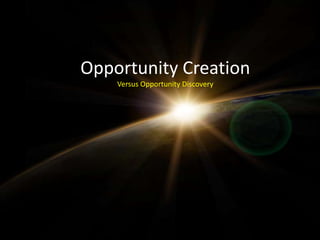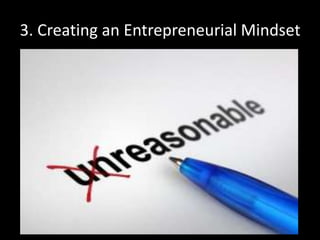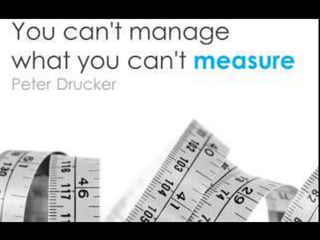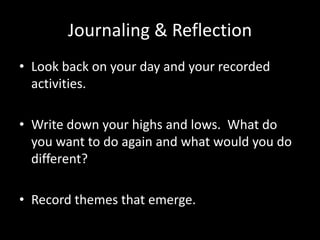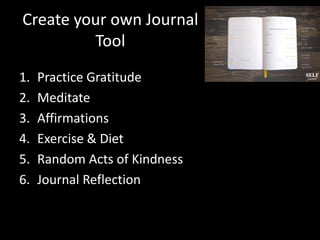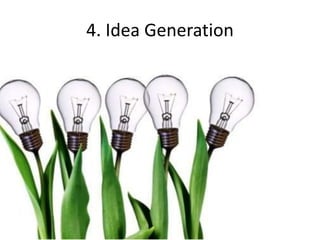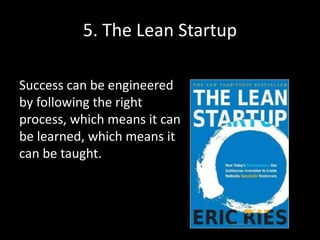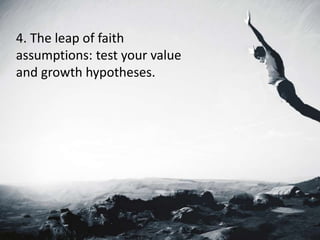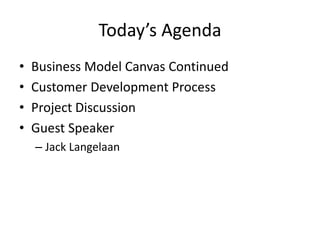Ent bootcamp
- 1. Bootcamp for Science Entrepreneurs, May 15 – 19, 2017 College of Health and Human Development & the Smeal College of Business
- 2. Week’s Agenda & Schedule
- 3. Today’s Agenda 1. Introductions/Team Formations 2. Introduction to Entrepreneurship 3. Creating an Entrepreneurial Mindset 4. The Lean Startup 5. Idea Generation 6. Business Model Canvas
- 13. 2. Introduction to Entrepreneurship
- 14. Opportunity Creation Versus Opportunity Discovery
- 19. We all face limits – not just in talent, but in opportunity. But more often than we think, our limits are self imposed. We try, fail and conclude we’ve bumped our heads against the ceiling of possibility. Or maybe after taking just a few steps we change direction. In either case, we never venture as far as we might have. To be gritty is to keep putting one foot in front of the other. To be gritty is to hold fast to an interesting and purposeful goal. To be gritty is to invest, day after week after year, in challenging practice. To be gritty is to fall down seven times, and rise eight. -Angela Duckworth
- 20. 3. Creating an Entrepreneurial Mindset
- 22. Do Entrepreneurs Think Differently Than Other People?
- 23. Effectuation theory a logic of control
- 25. Creating the necessary Habits
- 27. Gratitude
- 28. Practicing Gratitude 1. Think of 3 things that you are grateful for. 2. Spend 30 seconds to a minute truly in an emotional state of gratitude. 3. Write each one down.
- 30. Meditation • Download the app Headspace or Calm (or read Andy Putticombe’s book). • Meditate for 10 minutes each day. – This is not quiet time. This is NOT time to think. This requires mental practice and focus. • Record your completion.
- 32. Complete Written Affirmations 1. Allow yourself to dream of extremely lofty achievements. 2. Picture what it’s like to be living in that state. 3. Write down your affirmation, 15 times.
- 34. Exercise & Diet • Focus on the process not the end objective. • Establish simple routines that can be measured. • Record your successes and failures.
- 36. Practicing Random Acts of Kindness • Look for new ways to selflessly improve your world and those that live in it. (BEYOND YOUR NORMAL SELF). • Record your act and the feeling you got from completing it.
- 38. Journaling & Reflection • Look back on your day and your recorded activities. • Write down your highs and lows. What do you want to do again and what would you do different? • Record themes that emerge.
- 39. Create your own Journal Tool 1. Practice Gratitude 2. Meditate 3. Affirmations 4. Exercise & Diet 5. Random Acts of Kindness 6. Journal Reflection
- 43. 1. Collect Raw Materials 2. Use Your Subconscious Mind 3. Separate Analyzing and Generating 4. Think and Rest 5. Generate Many Ideas 6. Have Fun 7. Believe and Desire
- 46. Create your own Journal Tool 1. Practice Gratitude 2. Meditate 3. Affirmations 4. Exercise & Diet 5. Random Acts of Kindness 6. Journal Reflection 7. Idea Logging 8. Experiential Learning 9. Problem Solving
- 47. 5. The Lean Startup Success can be engineered by following the right process, which means it can be learned, which means it can be taught.
- 48. 1. Startups Need to be managed differently from established companies
- 49. 2. The purpose of the startup is to find a sustainable business model.
- 50. 3. Find your sustainable business model through validated learning.
- 51. 4. The leap of faith assumptions: test your value and growth hypotheses.
- 52. 6. Build, measure, learn – as fast and as often a possible.
- 53. 5. Develop a minimal viable product to test your idea.
- 54. 8. To find the right business model for your company, you usually have to pivot.
- 55. 9. Every startup should usually focus on one engine of growth.
- 56. What is a startup’s true runway?
- 57. 10. Vanity metrics are often flattering but misleading – they won’t help you find a sustainable business model.
- 58. 11. Every start-up has to define its core metrics and analyze them properly.
- 60. What is value?
- 61. Model of Service Tranference Based on SDL’s 4 Axioms Value Creating Actor 1 Value Creating Actor 2 Market Facing Resources Non Market Facing Resources Non Market Facing Resources timen Value proposition Value proposition A3 A4 A5 A6 A7 An SERVICE TRANSFER
- 62. Product Market Fit A. Technology Driven start with the VP B. Market Driven start with the Customer Segment
- 63. Your Product & Services Pain Killers • Savings? Time or Money • Feel Better? • Fix Bad Solutions? • End Challenges • Eliminate Risks? • Impact Social Consequences? Gain Creators • Happy customers? • Make life easier? • Better Outcomes?
- 64. Problem or Need • Rank each pain according to INTENSITY and FREQUENCY for your customer
- 65. Value Proposition - Common Mistakes • Feature of someone else’s product. • It’s nice to have instead of got to have • Demand + Enough Customers If you have to ask if you have PMF…. No.
- 66. Technology or Market Insights • New scientific discoveries – More efficient, smaller, faster, cheaper • Value Chain Disruption • Deregulation • Changes in how people work, live or interact – More convenient, better looking, design, etc. • Where there is overlap between the two you have a killer value proposition
- 67. Review 1. Introductions/Team Formations 2. Introduction to Entrepreneurship 3. Creating an Entrepreneurial Mindset 4. The Lean Startup 5. Idea Generation 6. Business Model Canvas • (Product Market Fit)
- 68. Today’s Agenda • Business Model Canvas Continued • Customer Development Process • Project Discussion • Guest Speaker – Jack Langelaan
- 69. 9 Questions 1. What value do we create? 2. For Whom do we create value? 3. How do we deliver value? 4. How do we communicate value? 5. How do we exchange value? 6. What resources do we need/have? 7. What skills do we need/have? 8. What partnerships do we need/have? 9. How much will it cost?
- 70. What value to we create? Jobs to be done
- 71. Customer Segments For whom do we create value?
- 73. Influencers 1. Competition/Market 2. Social 3. Psychological 4. Situational
- 74. Multi Sided Markets • Different marketing plan (v.p., c.s., ch, c.r. & rev model) for each segment
- 75. How do we deliver value?
- 76. How do we communicate value?
- 77. How do we exchange value?
- 78. What resources do we need/have?
- 79. What skills do we need/have? “Because the purpose of business is to create a customer, the business enterprise has two–and only two–basic functions: marketing and innovation. Marketing and innovation produce results; all the rest are costs. Marketing is the distinguishing, unique function of the business.” Peter Drucker
- 80. What partnerships do we need/have?
- 81. How much will it cost?
- 83. How can you create an MVP to engage customers?
- 84. How can we test our basic value and growth hypotheses?
- 85. DO YOU HAVE A REPEATABLE AND SCALABLE BUSINESS MODEL?
- 86. Project Development • Value proposition – What value have you created? • Channel Segments – For whom have you created value? • Supply Chains (If necessary) – How will you deliver value? • Marketing Communications – How will you communicate value? • Revenue Strategy – How will you exchange value? • Resources (Intellectual Property), Partnerships & Core Competencies (Include Management Team) – What resources do you have/need? • Financial Analysis – What metrics matter? Will it be profitable? • Customer Development Plan – How can you test your assumptions to determine if you have scalable and repeatable business model? • Call to Action – What do you need work on next and how could someone help you get there?
- 87. Jack Langelaan
Editor's Notes
- #73: What are the jobs that customers want you to do? Understand in enough detail that you could draw a customer persona of your ideal customer on the wall.














